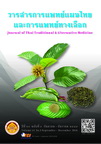วิธีทางเลือกเพื่อควบคุมคุณภาพฟ้าทะลายแคปซูลตามตำรามาตรฐานยาสมุนไพรไทย
Main Article Content
บทคัดย่อ
หลักการและวัตถุประสงค์: รีฟลักซ์เป็นการเตรียมตัวอย่างตามวิธีมาตรฐานในตำรามาตรฐานยาสมุนไพรไทยสำหรับการวิเคราะห์ปริมาณแอนโดรกราโฟไลด์ในวัตถุดิบสมุนไพรและฟ้าทะลายแคปซูลที่ใช้มาตั้งแต่ปี พ.ศ. 2538 วิธีนี้มีข้อเสียคือใช้ตัวทำละลายอินทรีย์ที่ระเหยง่ายและอันตรายในปริมาณสูง ประสิทธิภาพในการสกัดต่ำ และใช้เวลานาน การศึกษานี้มีวัตถุประสงค์เพื่อเปรียบเทียบประสิทธิภาพของวิธีสกัดแบบดั้งเดิมกับการใช้คลื่นเสียงความถี่สูงและเสนอเป็นวิธีทางเลือกในการเตรียมตัวอย่างเพื่อควบคุมคุณภาพฟ้าทะลายแคปซูลตามตำรามาตรฐานยาสมุนไพรไทยฉบับปัจจุบัน
ระเบียบวิธีศึกษา: หาตัวทำละลายและระยะเวลาสกัดที่เหมาะสมที่สุดในการเตรียมตัวอย่างโดยใช้คลื่นเสียงความถี่สูง แล้วนำมาเปรียบเทียบประสิทธิภาพการสกัดกับวิธีรีฟลักซ์โดยทดลองกับฟ้าทะลายแคปซูลจำนวน 30 ตัวอย่าง วิธีวิเคราะห์ปริมาณแอนโดรกราโฟไลด์ตามที่ระบุในตำรามาตรฐานยาสมุนไพรไทยได้ผ่านการตรวจสอบความถูกต้องซ้ำอีกครั้งเพื่อให้แน่ใจว่าวิธีดังกล่าวยังคงมีประสิทธิภาพดีและมีความถูกต้องน่าเชื่อถือหลังจากมีการเปลี่ยนแปลงวิธีการเตรียมตัวอย่าง
ผลการศึกษา: การเตรียมตัวอย่างโดยใช้คลื่นเสียงความถี่สูงนาน 15 นาทีและมีเมทานอล 50% เป็นตัวทำละลายให้ปริมาณแอนโดรกราโฟไลด์ที่สกัดได้สูงสุด การเปลี่ยนแปลงวิธีเตรียมตัวอย่างไม่มีผลกระทบต่อประสิทธิภาพของวิธีวิเคราะห์ ปริมาณแอนโดรกราโฟไลด์ที่สกัดได้จากการใช้คลื่นเสียงความถี่สูงมีค่าใกล้เคียงและส่วนใหญ่จะมีค่าสูงกว่าการสกัดด้วยวิธีรีฟลักซ์
อภิปรายและสรุปผล: การเตรียมตัวอย่างโดยใช้คลื่นเสียงความถี่สูงเป็นวิธีที่มีประสิทธิภาพ รวดเร็ว และสะดวกกว่าวิธีรีฟลักซ์ สามารถนำมาใช้เป็นวิธีทางเลือกในการเตรียมตัวอย่างเพื่อควบคุมคุณภาพฟ้าทะลายแคปซูลตามตำรามาตรฐานยาสมุนไพรไทยฉบับปัจจุบันได้
Article Details
References
2. Poolsup N, Suthisisang C, Prathanturarug S, Asawamekin A, Chanchareon U. Andrographis paniculata in the symptomatic treatment of uncomplicated upper respiratory tract infection: systematic review of randomized controlled trials. J Clin Pharm Ther. 2004;29(1):37-45.
3. Gupta S, Yadava JNS, Tandon JS. Antisecretory (antidiarrhoeal) activity of Indian medicinal plants against Escherichia coli enterotoxin-induced secretion in rabbit and guinea pig ileal loop models. Pharm Biol. 1993;31:198-204.
4. Handa SS, Sharma A. Hepatoprotective activity of andrographolide from Andrographis paniculata against carbon tetrachloride. Indian J Med Res. 1990;92:276-83.
5. Shen YC, Chen CF, Chiou WF. Andrographolide prevents oxygen radical production by human neutrophils: possible mechanism(s) involved in its anti-inflammatory effect. Br J Pharmacol. 2002;135:399-406.
6. Amroyan E, Gabrielian E, Panossian A, Wikman G, Wagner H. Inhibitory effect of andrographolide from Andrographis paniculata on PAF induced platelet aggregation. Phytomedicine. 1999;6:27-31.
7. Thamlikitkul V, Dechatiwongse T, Theerapong S, Chantrakul C, Boonroj P, Punkrut W, et al. Efficacy of Andrographis paniculata. Nees for pharyngotonsillitis in adults. J Med Assoc Thai. 1991;74:437-42.
8. Kapil A, Koul IB, Banerjee SK, Gupta BD. Antihepatotoxic effects of major diterpenoid constituents of Andrographis paniculata. Biochem Pharmacol. 1993;46(1):182-5.
9. Cáceres DD, Hancke JL, Burgos RA, Sandberg F, Wikman GK. Use of visual analogue scale measurements (VAS) to assess the effectiveness of standardized Andrographis paniculata extract SHA-10 in reducing the symptoms of common cold. A randomized double blind-placebo study. Phytomedicine. 1999;6:217-23.
10. Melchior J, Spasov AA, Ostrovskij OV. Double blind placebocontrolled pilot and phase III studyof activity of standardized Andrographis paniculta Herba Nees extract fixed combination (Kan jang) in the treatment of uncomplicated upper respiratory tract infection. Phytomedicine. 2000;7:341-50.
11. Coon JT, Ernst E. Andrographis paniculata in the treatment of upper respiratory tract infections: A systematic review of safety and efficacy. Planta medica. 2004;70:293-8.
12. Premendran SJ, Salwe KJ, Pathak S, Brahmane R, Manimekalai K. Anti-cobra venom activity of plant Andrographis paniculata and its comparison with polyvalent anti-snake venom. J Nat Sci Biol Med. 2011;2(2):198-204.
13. Calabrese C, Berman SH, Babish JG, Ma XF, Shinto L, Dorr M, et al. A phase I trial of andrographolide in HIV positive patients and normal volunteers. Phytother Res. 2000;14:333-8.
14. Rajagopal S, Kumar RA, Deevi DS, Satyanarayana C, Rajagopalan R. Andrographolide, a potential cancer therapeutic agent isolated from Andrographis paniculata. J Exp Ther Oncol. 2003;3:147-58.
15. Cheung HY, Cheung SH, Li J, Cheung CS, Lai WP, Fong WF, et al. Andrographolide isolated from Andrographis paniculata induces cell cycle arrest and mitochondrial mediated apoptosis in human leukemic HL-60 cells. Planta Med. 2005;71:1106-11.
16. Li J, Cheung HY, Zhang Z, Chan GKL, Fong WF. Andrographolide induces cell cycle arrest at G2/M phase and cell death in HepG2 cells via alteration of reactive oxygen species. Eur J Pharmacol. 2007;568:31-44.
17. Koteswara RY, Vimalamma G, Venkata RC, Tzeng YM. Flavonoids and andrographolides from Andrographis paniculata. Phytochemistry. 2004;65:2317-21.
18. Smith PL, Maloney KN, Pothen RG, Clardy J, Clapham DE. Bisandrographolide from Andrographis paniculata activates TRPV4 channels. J Biol Chem. 2006;281:29897-904.
19. Chen L, Zhu H, Wang R, Zhou K, Jing Y, Qiu F. Ent-labdane diterpenoid lactone stereoisomers from Andrographis paniculata. J Nat Prod. 2008;71:852-5.
20. Chen LX, Qiu F, Wei H, Qu GX, Yao XS. Nine new ent-labdane diterpenoids from the aerial parts of Andrographis paniculata. Helv Chim Acta. 2006;89:2654-64.
21. National Drug Committee. List of Herbal Medicinal Products. Bangkok: The Agricultural Co-operative Federation of Thailand, Limited; 2006. p.18-9.
22. Department of Medical Sciences, Ministry of Public Health. Thai Herbal Pharmacopoeia Volume I. Bangkok: Office of National Buddishm Press; 2009. p. 24-31.
23. Department of Medical Sciences, Ministry of Public Health. Supplement to Thai Herbal Pharmacopoeia. Bangkok: Prachachon Co., Ltd.; 2004. p. 29-30.
24. Department of Medical Sciences, Ministry of Public Health. Thai Herbal Pharmacopoeia Volume III. Bangkok: Office of National Buddishm Press; 2009. p. XI-XII.
25. Kumoro AC, Hasan M. Supercritical carbon dioxide extraction of andrographolide from Andrographis paniculata: Effect of the solvent flow rate, pressure, and temperature. Chin J Chem Eng. 2007;15:877-83.
26. Kumoro AC, Hasan M. Modeling of supercritical carbon dioxide extraction of andrographolide from Andrographis paniculata leaves. Chem Eng Commun. 2008;195:72-80.
27. Vijaykumar1 K, Murthy PBS, Kannababu S, Syamasundar B, Subbaraju GV. Estimation of adrographolide in Andrographis paniculata herb, extracts and dosage forms. Int J Appl Sci Eng. 2007;5(1):27-39.
28. Xu T, Pan J, Zhao L. Simultaneous determination of four andrographolides in Andrographis paniculata Nees by silver ion reversed-phase high-performance liquid chromatography. J Chromtogr Sci. 2008;46(8):747-5.
29. Daodee S, Wangboonskul, Jarukamjorn, Sripanidkulchai B. The consideration of quality control criteria for Andrographis paniculata products. KKU res J. 2006;11(4):319-27.
30. Jain PK, Ravichandran V, Jain PK, Agrawal RK. High-performance thin layer chromatography method for estimation of andrographolide in herbal extract and polyherbal formulations. J Saudi Chem Soc. 2010;14(4):383-9.
31. Sajeeb BK, Kumar U, Halder S, Bachar SC. Identification and quantification of Andrographolide from Andrographis paniculata (Burm. f.) Wall. ex Nees by RP-HPLC method and standardization of its market preparations. Dhaka Univ J Pharm Sci.2015;14(1):71-8.
32. ICH Steering Committee. International Conference on Harmonization of Technical Requirements for Registration of Pharmaceuticals for Human Use. Validation of analytical procedures: text and methodology Q2(R1). 2005.
33. Kumoro AC, Hasan M,Singh H. Effects of solvent properties on the Soxhlet extraction of diterpenoid lactones from Andrographis paniculata leaves. Sci Asia. 2009;35:306-9.

